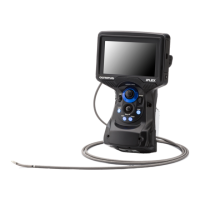Chapter 3 Preparation and Inspection
81
EVIS LUCERA GIF/CF/PCF TYPE 260 Series OPERATION MANUAL
3. Cover the hole in the air/water valve with your finger and confirm that air
bubbles are continuously emitted from the air/water nozzle.
4. Uncover the hole in the air/water valve and confirm that no air bubbles are
emitted from the air/water nozzle.
If a stream of air bubbles is emitted from the air/water nozzle
even though the air/water valve is not being operated and the
distal end of the insertion section is 10 cm or more below the
surface of the sterile water, there may be an irregularity in the
air-feeding function. If the endoscope is used while air is
continuously fed, over-insufflation and patient injury may
result. If air bubbles are emitted from the air/water nozzle,
remove and reattach the air/water valve correctly, or replace
it with a new one. If this fails to stop air bubbles from being
emitted, do not use the endoscope because there may be a
malfunction. Contact Olympus.
When the distal end of the insertion section is immersed less
than 10 cm below the surface of the sterile water, a small
amount of air bubbles may be emitted from the air/water
nozzle even when the air/water valve is not operated. This
does not indicate a malfunction.
Inspection of the objective lens cleaning function
Nothing other than sterile water should be used for air/water
feeding. No additives should be put into the sterile water.
Non-sterile water may cause patient cross-contamination
and/or infection.
• When the air/water valve is depressed for the first time, it
may take a few seconds before water is emitted.
• If the air/water valve returns to its original position slowly after
water feeding, remove the air/water valve and moisten the
seals with sterile water.
• During the inspection, place the distal end of the endoscope
in a beaker or other container so that the floor does not get
wet.

